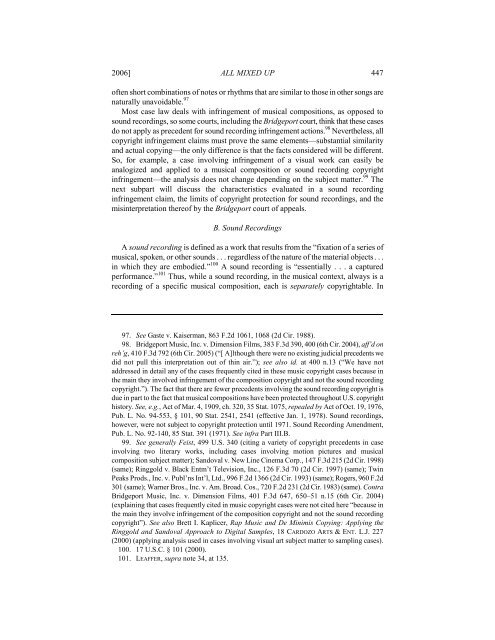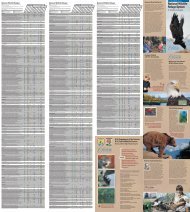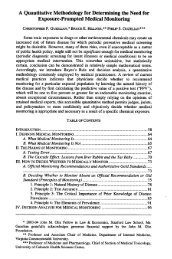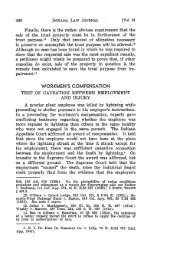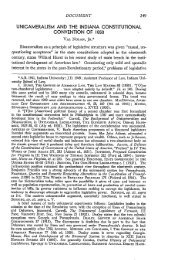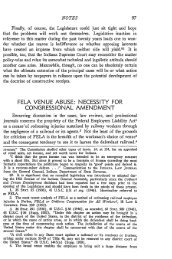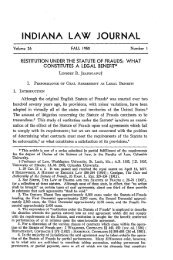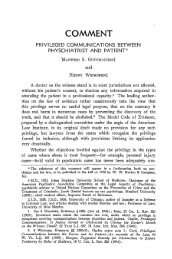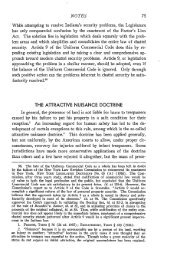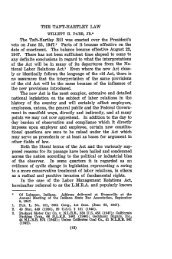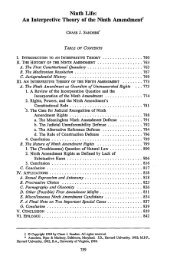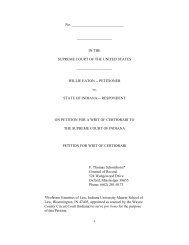Bridgeport Music v. Dimension Films - Indiana University School of ...
Bridgeport Music v. Dimension Films - Indiana University School of ...
Bridgeport Music v. Dimension Films - Indiana University School of ...
You also want an ePaper? Increase the reach of your titles
YUMPU automatically turns print PDFs into web optimized ePapers that Google loves.
2006] ALL MIXED UP 447<br />
<strong>of</strong>ten short combinations <strong>of</strong> notes or rhythms that are similar to those in other songs are<br />
naturally unavoidable. 97<br />
Most case law deals with infringement <strong>of</strong> musical compositions, as opposed to<br />
sound recordings, so some courts, including the <strong>Bridgeport</strong> court, think that these cases<br />
do not apply as precedent for sound recording infringement actions. 98 Nevertheless, all<br />
copyright infringement claims must prove the same elements—substantial similarity<br />
and actual copying—the only difference is that the facts considered will be different.<br />
So, for example, a case involving infringement <strong>of</strong> a visual work can easily be<br />
analogized and applied to a musical composition or sound recording copyright<br />
infringement—the analysis does not change depending on the subject matter. 99 The<br />
next subpart will discuss the characteristics evaluated in a sound recording<br />
infringement claim, the limits <strong>of</strong> copyright protection for sound recordings, and the<br />
misinterpretation there<strong>of</strong> by the <strong>Bridgeport</strong> court <strong>of</strong> appeals.<br />
B. Sound Recordings<br />
A sound recording is defined as a work that results from the “fixation <strong>of</strong> a series <strong>of</strong><br />
musical, spoken, or other sounds . . . regardless <strong>of</strong> the nature <strong>of</strong> the material objects . . .<br />
in which they are embodied.” 100 A sound recording is “essentially . . . a captured<br />
performance.” 101 Thus, while a sound recording, in the musical context, always is a<br />
recording <strong>of</strong> a specific musical composition, each is separately copyrightable. In<br />
97. See Gaste v. Kaiserman, 863 F.2d 1061, 1068 (2d Cir. 1988).<br />
98. <strong>Bridgeport</strong> <strong>Music</strong>, Inc. v. <strong>Dimension</strong> <strong>Films</strong>, 383 F.3d 390, 400 (6th Cir. 2004), aff’d on<br />
reh’g, 410 F.3d 792 (6th Cir. 2005) (“[ A]lthough there were no existing judicial precedents we<br />
did not pull this interpretation out <strong>of</strong> thin air.”); see also id. at 400 n.13 (“We have not<br />
addressed in detail any <strong>of</strong> the cases frequently cited in these music copyright cases because in<br />
the main they involved infringement <strong>of</strong> the composition copyright and not the sound recording<br />
copyright.”). The fact that there are fewer precedents involving the sound recording copyright is<br />
due in part to the fact that musical compositions have been protected throughout U.S. copyright<br />
history. See, e.g., Act <strong>of</strong> Mar. 4, 1909, ch. 320, 35 Stat. 1075, repealed by Act <strong>of</strong> Oct. 19, 1976,<br />
Pub. L. No. 94-553, § 101, 90 Stat. 2541, 2541 (effective Jan. 1, 1978). Sound recordings,<br />
however, were not subject to copyright protection until 1971. Sound Recording Amendment,<br />
Pub. L. No. 92-140, 85 Stat. 391 (1971). See infra Part III.B.<br />
99. See generally Feist, 499 U.S. 340 (citing a variety <strong>of</strong> copyright precedents in case<br />
involving two literary works, including cases involving motion pictures and musical<br />
composition subject matter); Sandoval v. New Line Cinema Corp., 147 F.3d 215 (2d Cir. 1998)<br />
(same); Ringgold v. Black Entm’t Television, Inc., 126 F.3d 70 (2d Cir. 1997) (same); Twin<br />
Peaks Prods., Inc. v. Publ’ns Int’l, Ltd., 996 F.2d 1366 (2d Cir. 1993) (same); Rogers, 960 F.2d<br />
301 (same); Warner Bros., Inc. v. Am. Broad. Cos., 720 F.2d 231 (2d Cir. 1983) (same). Contra<br />
<strong>Bridgeport</strong> <strong>Music</strong>, Inc. v. <strong>Dimension</strong> <strong>Films</strong>, 401 F.3d 647, 650–51 n.15 (6th Cir. 2004)<br />
(explaining that cases frequently cited in music copyright cases were not cited here “because in<br />
the main they involve infringement <strong>of</strong> the composition copyright and not the sound recording<br />
copyright”). See also Brett I. Kaplicer, Rap <strong>Music</strong> and De Minimis Copying: Applying the<br />
Ringgold and Sandoval Approach to Digital Samples, 18 CARDOZO ARTS & ENT. L.J. 227<br />
(2000) (applying analysis used in cases involving visual art subject matter to sampling cases).<br />
100. 17 U.S.C. § 101 (2000).<br />
101. LEAFFER, supra note 34, at 135.


